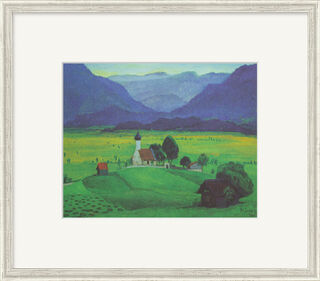Picture "Ramsach Church" (1928), framed


Picture "Ramsach Church" (1928), framed
Quick info
limited, 500 copies | facsimile print on handmade paper | framed | passe-partout | glazed | size approx. 57 x 65 cm (h/w)
Detailed description
Picture "Ramsach Church" (1928), framed
Original: Oil on cardboard, private property.
5-colour facsimile edition in hybrid process on 260g Rives handmade paper. Limited edition of 500 copies. Motif size 33 x 41 cm (h/w). Sheet size 48 x 60 cm (h/w). In silver solid wood frame with passe-partout, glazed. Size approx. 57 x 65 cm (h/w). © AKG-Images, © VG Bild-Kunst, Bonn 2020.
Frame configurator
Customised picture frame

Frame configurator
Customised picture frame







About Gabriele Münter
1877-1962
Gabriele Münter was an Expressionist painter and a member of the New Munich Artists' Association but did not belong to the Blaue Reiter movement.
Gabriele Münter became known as Wassily Kandinsky's companion. She saved a significant part of his works through the war and post-war period and later made them known to the public, together with paintings by artist friends of the Blaue Reiter and her own works.
When Gabriele Münter bought a house in Murnau in 1909, which she lived in during the summer with her partner Kandinsky, the idyllically situated domicile soon developed into a centre of the avant-garde. Marc, Macke and Werefkin, Jawlensky were regular guests. They all found much inspiration for their artistic work in the area around the Staffelsee – art history likes to describe these years surrounding the founding of the Blaue Reiter as the "Murnau period".
With the beginning of the First World War and the separation from Kandinsky, turbulent years followed for Münter. In 1931, she moved to Murnau for good. The landscape in the foothills of the Bavarian Alps plays a major role in her work from this period, as it did at the beginning of the century. When Münter died in Murnau in 1962, she had long been considered, along with Paula Modersohn-Becker, the most important Expressionist painter.
Artistic movement that replaced Impressionism in the early 20th century.
Expressionism is the German form of the art revolution in painting, graphic art and sculpture, which found its precursor in the works of Paul Cézanne, Vincent van Gogh and Paul Gauguin in the late 19th century. The Expressionists attempted to advance to the primal elements of painting. With vibrant, unbroken colours in large areas and with the emphasis on the line and the resulting targeted suggestive expressiveness, they fought against the artistic taste established by the bourgeoisie.
The most important representatives of Expressionism were the founders of "Die Brücke" (The Bridge): Ernst Ludwig Kirchner, Erich Heckel, Karl Schmidt-Rottluff, Max Pechstein, Otto Mueller and Franz Marc, August Macke and others.
Masters of Viennese Expressionism are Egon Schiele and Oskar Kokoschka. Among the sculptors, Ernst Barlach is the most famous.
Fauvism is the French form of Expressionism.
Latin: "to make alike".
Largely faithful reproduction of an original document, e.g. old manuscripts and codices. (Facsimile edition).


